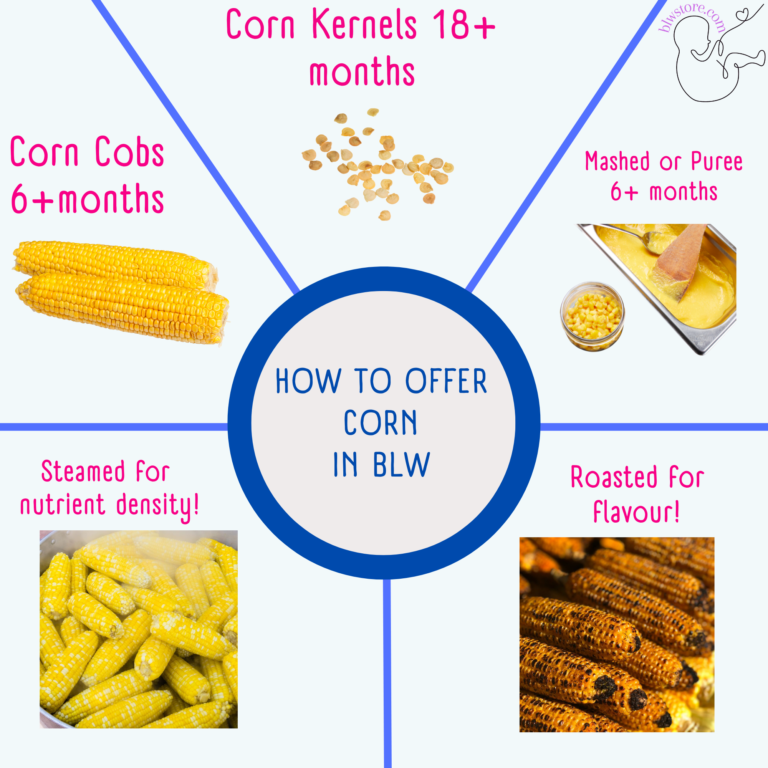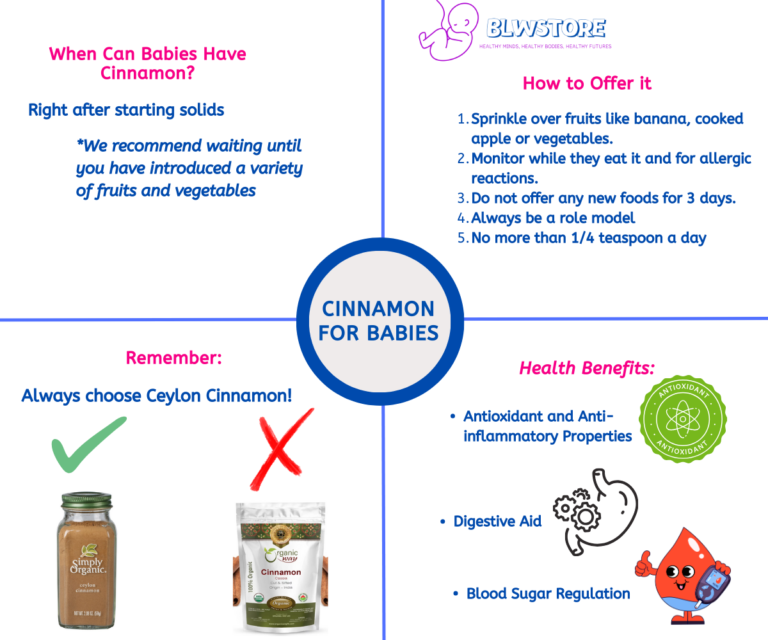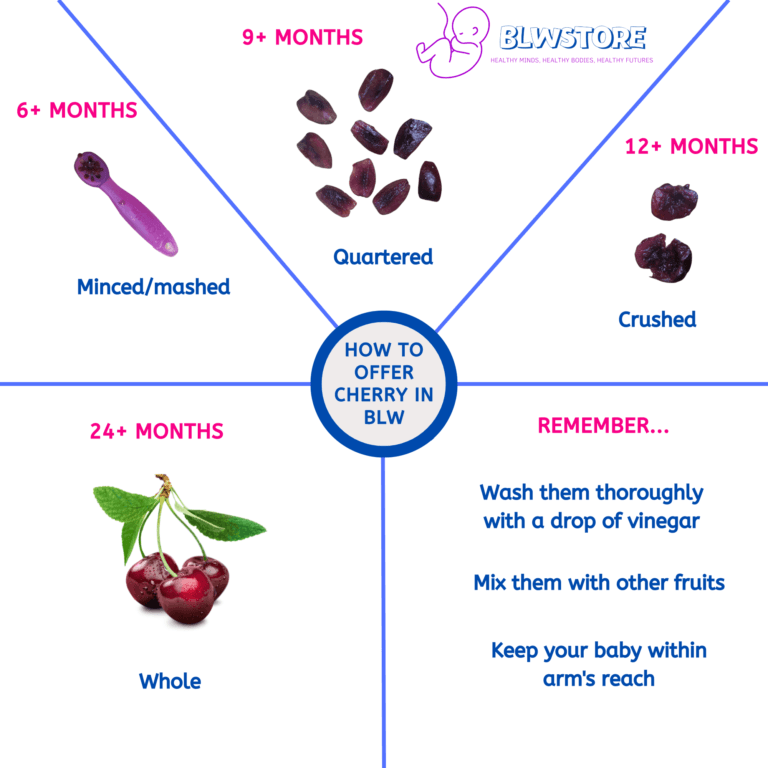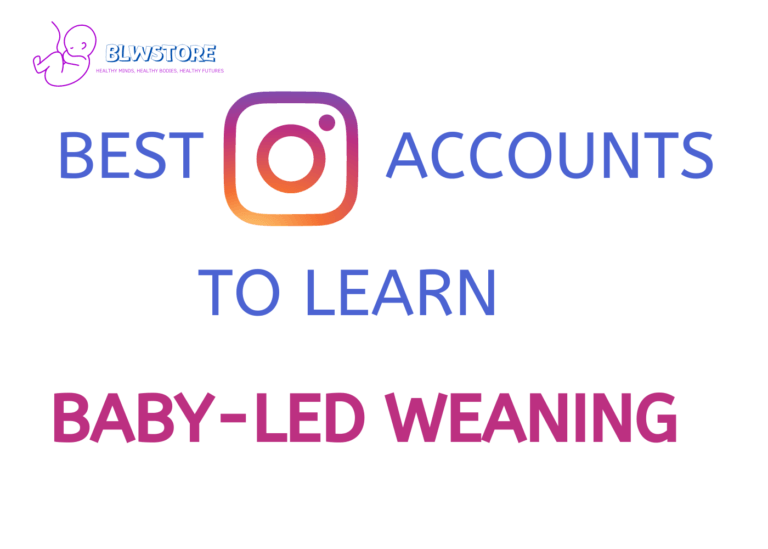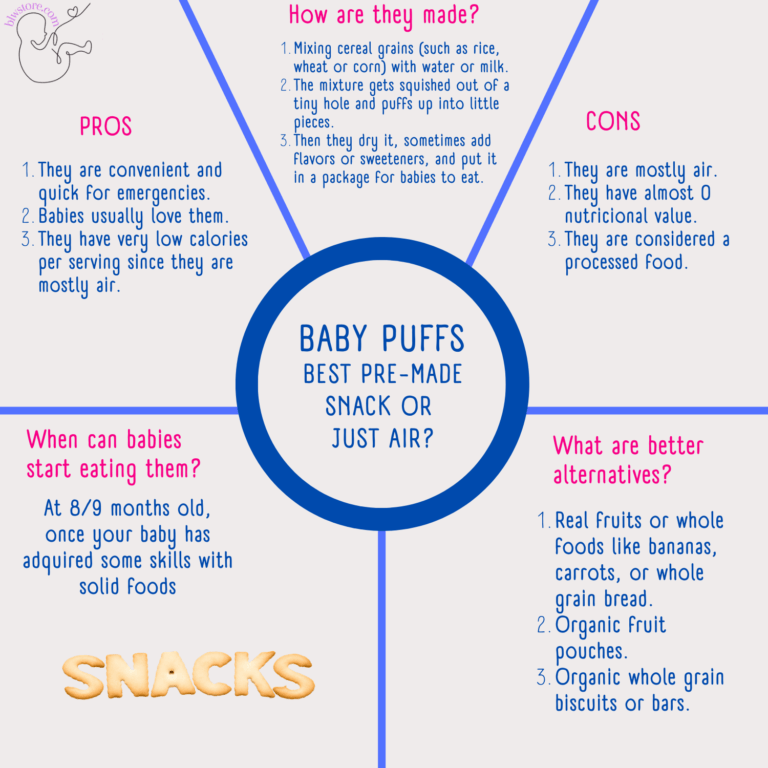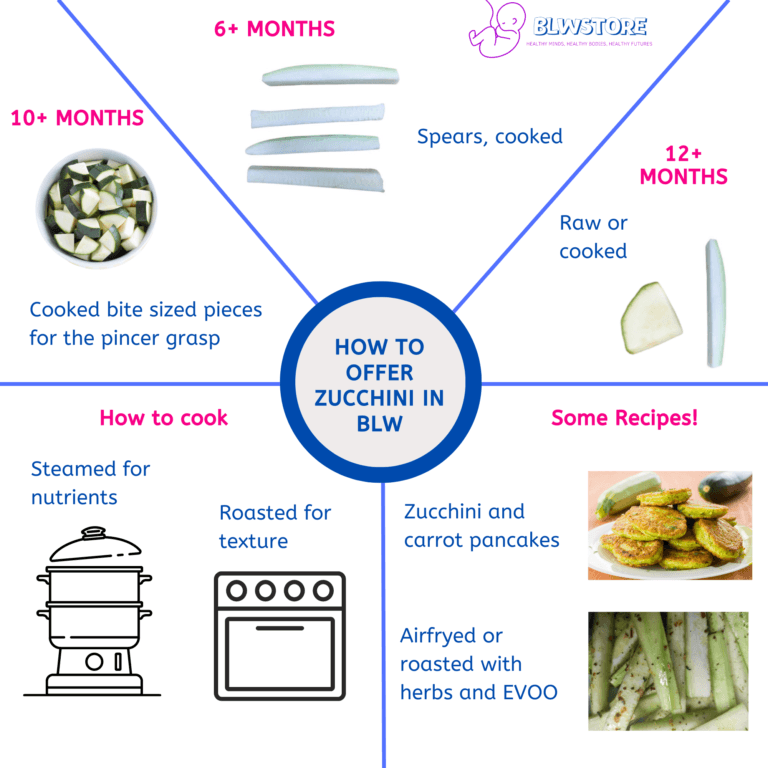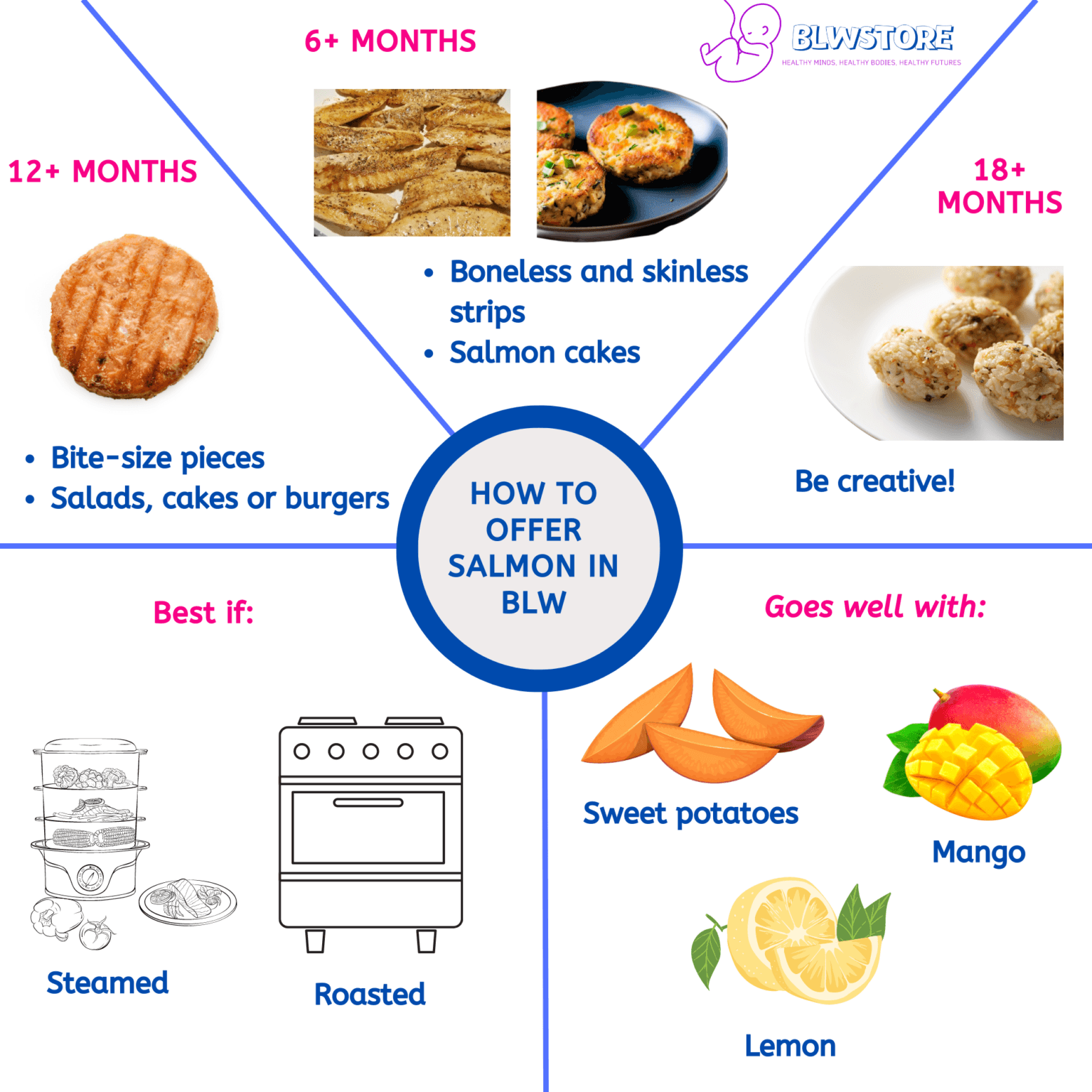
In this article, we’ll give you all the information you need about feeding salmon to your baby.
You will also find quick, wholesome salmon recipes to introduce this nutritious fish.
Whether you are a pro in Baby-Led Weaning or your baby is starting with solid foods, we’ve got you covered.
Let’s get after it!
| Salmon for Baby: Key Takeaways |
|---|
| Babies can start eating salmon as early as six months old, as long as it’s cooked and offered in an age-appropriate way. |
| For infants 12 months and older, we can offer salmon in bite-size pieces. |
| Wild-caught salmon is advised over farm-raised salmon wherever it is practical. |
| Look for canned salmon selections that are low in sodium and free of added sugars and preservatives when shopping for your infant. |
| Fresh salmon is typically favored due to its flavor and texture. |
| Properly defrosting frozen salmon is essential to ensure that it is safe to eat and that the fatty fish retains its texture and flavor. |
| Introducing salmon into your baby’s diet can be an exciting and nutritious first food option, packed with essential nutrients for growing babies. |
Can Babies Eat Salmon?
Of course, they can and they should!
Salmon is one of the most nutritious fish and one of the most beneficial for babies as well.
It’s high in healthy fats that are perfect for your growing baby and has high-quality and bioavailable proteins.
Having said that, you should always be careful with the amount of daily protein you give your baby.
Here’s a chart to help you out:
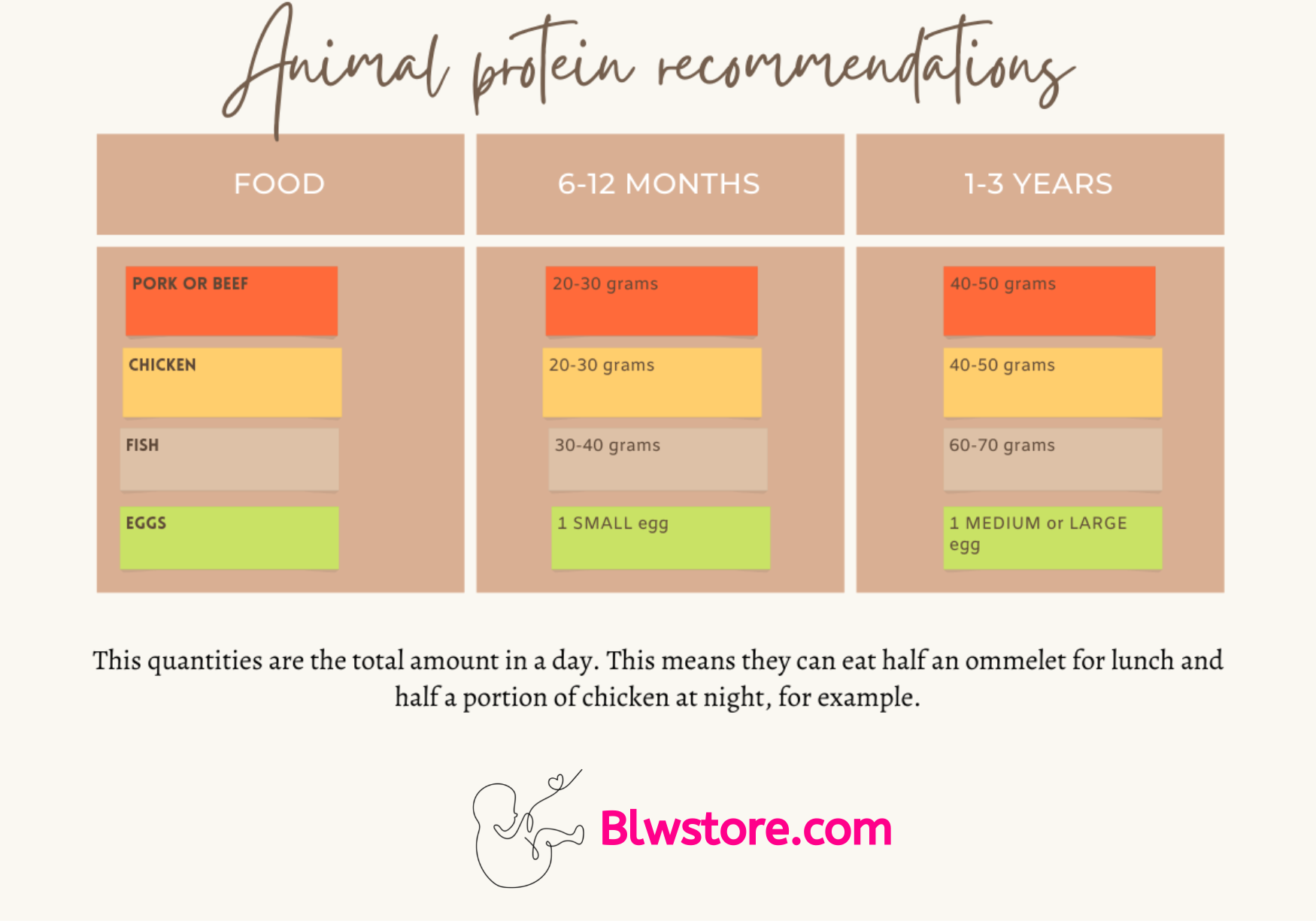
When can babies eat salmon?
Babies can start eating salmon as early as six months old, as long as it’s cooked and offered in an age-appropriate way.
Because salmon is a low-mercury fish that offers vital nutrients like omega-3 fatty acids and vitamin D, you should introduce it to your baby’s diet as soon as possible.
These nutrients are crucial for the growth and wellness of the entire body and the development of the brain and neurological system.
How to offer salmon to your baby
6 – 12 months
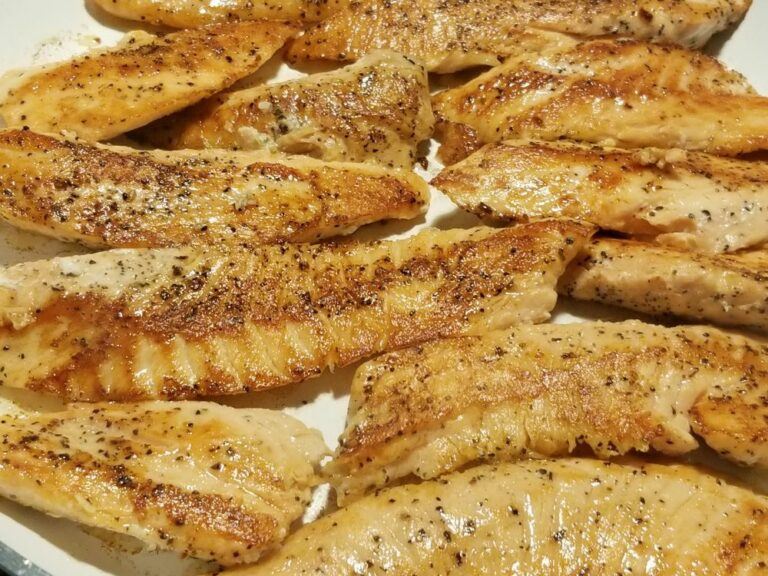
Babies 6 to 12 months can be offered freshly cooked salmon in boneless and skinless strips, about the size of two adult fingers, or flaked and mixed with soft foods that can be spooned.
If you offer canned salmon with some added salt, rinse it with water to reduce sodium levels and mix it with other foods.
Salmon cakes or rice balls can also be offered at this age, as long as they are larger than the baby’s mouth, to avoid choking.
12 – 18 months

For infants 12 months and older, we can offer salmon in bite-size pieces.
We can be more creative and offer it in cakes, burgers, or salads with avocado and other previously introduced foods.
We can also offer it in long strips of salmon fillet to practice biting.
18 + months
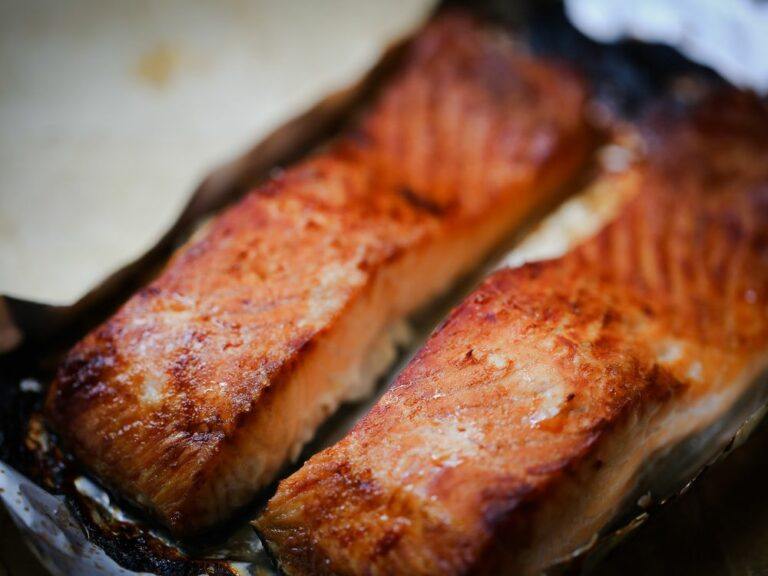
For infants over 18 months, it is time to introduce salmon-eating utensils.
Smoked salmon should be avoided, if possible, for up to 24 months and even up to 36 months.
We can be as creative as we want with our recipes if we are careful with the salt we add.
Choosing Salmon for Baby-Led Weaning
Choose wild-caught salmon for superior nutrition and lower contamination risk, and consider frozen salmon as a practical, nutrient-dense alternative to fresh salmon for your baby-led weaning journey.
Wild Caught Salmon Vs. Farm Raised Salmon
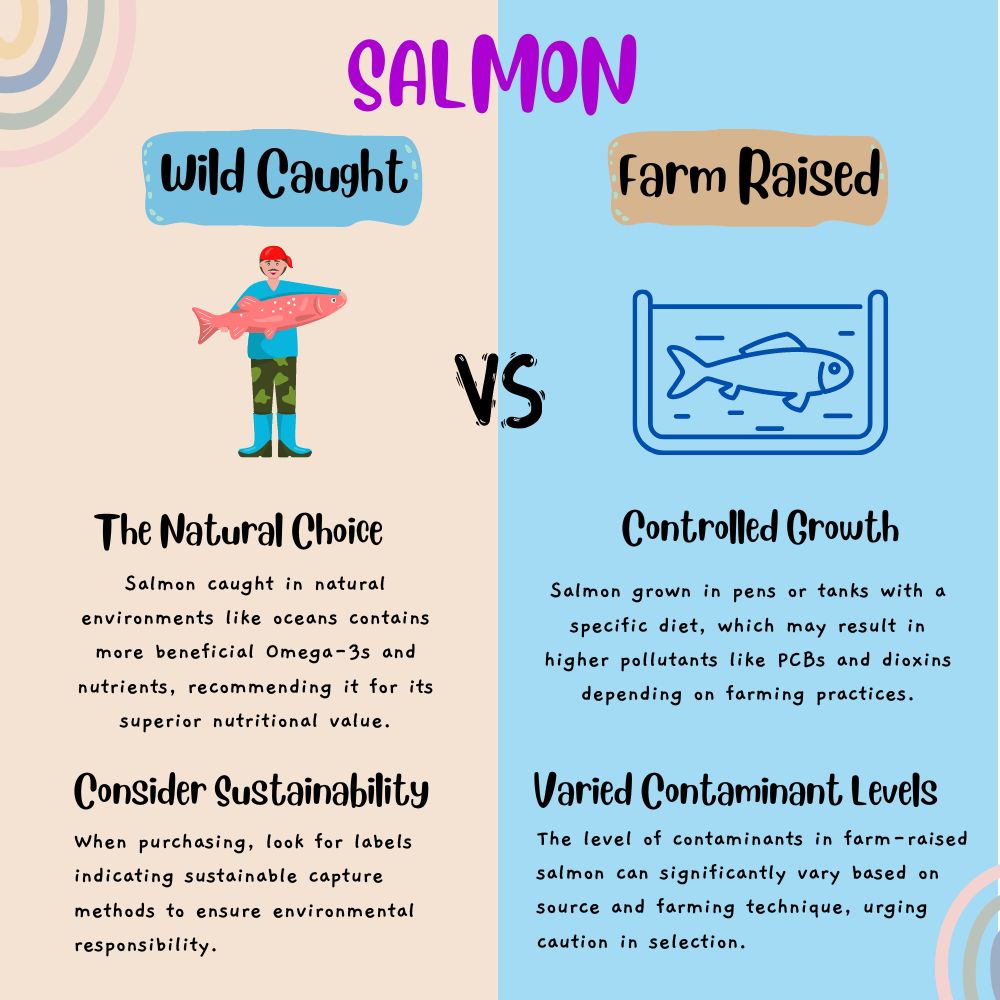
Salmon caught in its natural environment, typically an ocean or other body of water, is known as wild-caught salmon.
This variety typically has more beneficial Omega-3 fatty acids and other nutrients than salmon raised on farms.
But farm-grown salmon is kept in pens or tanks and given a specific diet. Due to their food and environment, this variety of salmon may have greater concentrations of pollutants, including PCBs and dioxins.
Notably, depending on the source and farming technique, the contaminants in farm-raised salmon might vary significantly.
Due to its superior nutritional value and decreased danger of contamination, wild-caught salmon is advised over farm-raised salmon wherever it is practical.
When purchasing salmon, check for labels that say the fish was captured or raised sustainably.
Canned Salmon
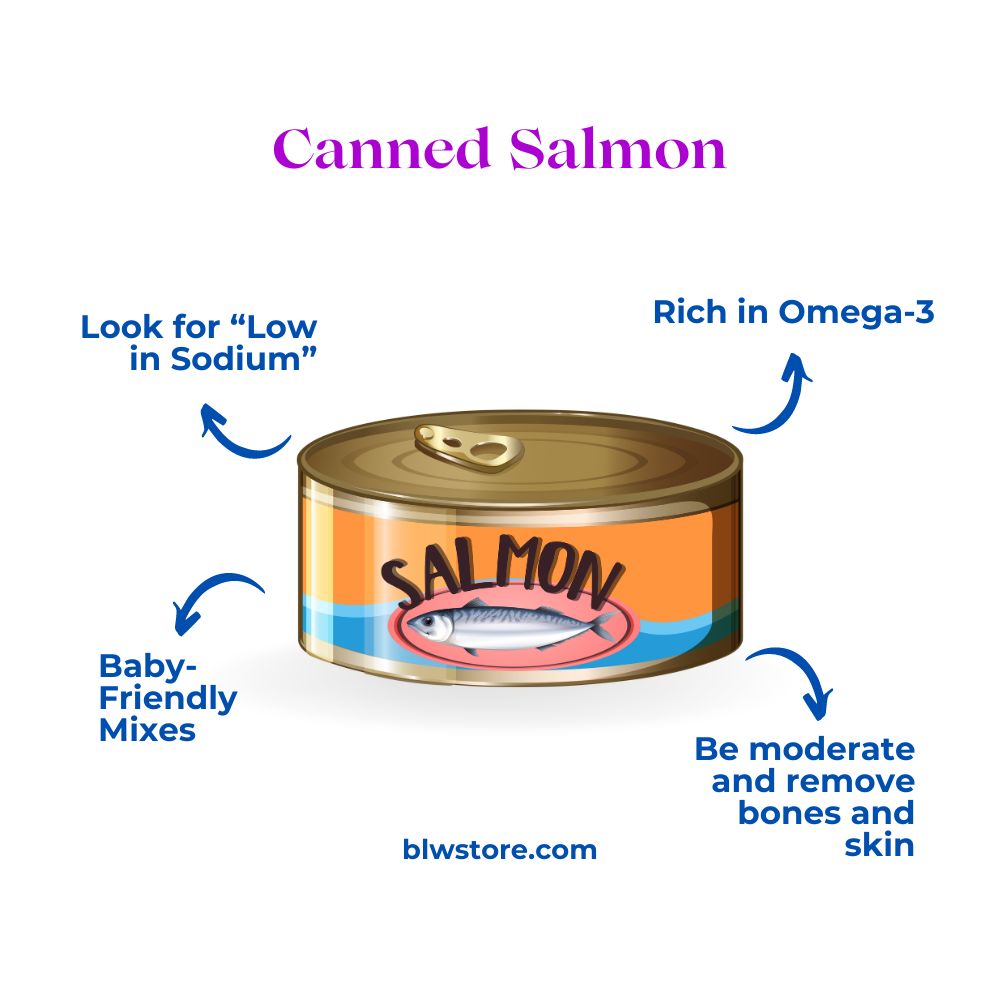
Look for canned salmon selections that are low in sodium and free of added sugars and preservatives when shopping for your infant.
In addition, wild-caught canned salmon may include higher quantities of Omega-3 fatty acids and other nutrients.
You may mash canned salmon with a fork and serve it as is or combine it with other baby-friendly foods such as smashed avocado or sweet potato.
Remove any bones or skin before serving, and attentively monitor your infant to ensure they can manage the texture.
It is also crucial to know that due to the processing, canned salmon may contain higher levels of mercury than fresh salmon. So, it is advisable to have canned salmon no more than once each week.
Frozen Salmon Vs. Fresh Salmon
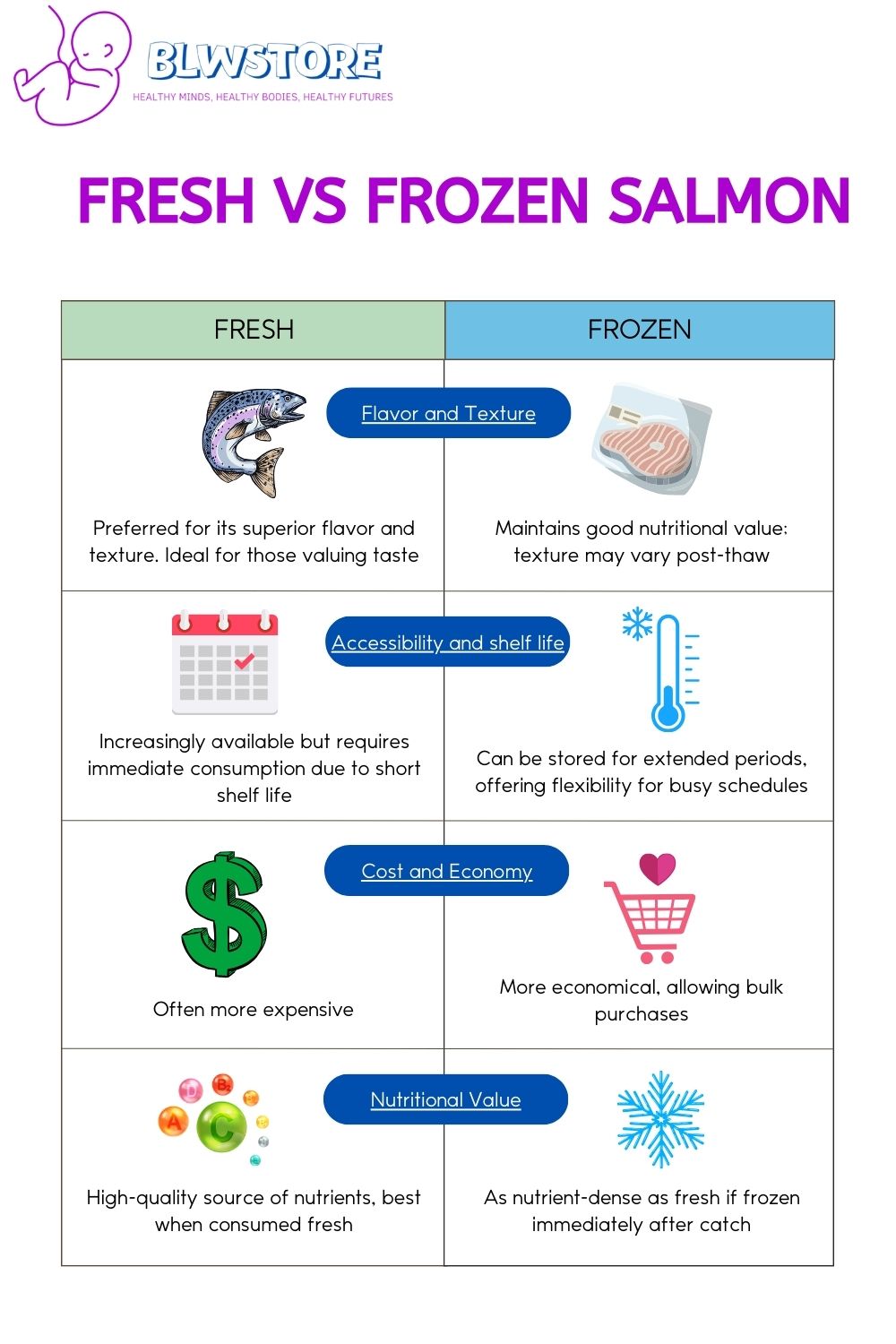
Fresh salmon is typically favored due to its flavor and texture. Also, it is increasingly accessible at grocery stores and fish markets.
However, fresh salmon can be more expensive and has a shorter shelf life, necessitating immediate consumption.
In contrast, frozen salmon is a practical and economical solution for parents. It may be purchased in large quantities and stored in the freezer for later use, making it a fantastic alternative for families with hectic schedules.
In addition, while it is usually frozen immediately after being collected to maintain its nutritional value, frozen salmon can be as nutrient-dense as fresh salmon.
Look for frozen salmon free of additives and preservatives when purchasing it for your infant.
There is nothing wrong with selecting frozen salmon as a simple and economical alternative for your infant.
It is an excellent alternative if you have access to fresh salmon and like its flavor and texture.
It is essential to buy high-quality salmon and prepare it in a manner that is nutritious and appropriate for your infant.
How to defrost and cook frozen salmon for your baby
Properly defrosting frozen salmon is essential to ensure that it is safe to eat and that the fatty fish retains its texture and flavor.
Here are some steps to defrost and cook frozen salmon for your baby:
- Defrost the salmon: Thaw frozen salmon by placing it in the refrigerator overnight or running it under cold water for a few minutes. Avoid using hot water, which can cause the salmon to cook unevenly and lose its texture.
- Prepare the salmon: Once fully thawed, remove any bones or skin and cut it into small pieces appropriate for your baby’s age.
- Can you cook frozen salmon directly? You can cook frozen salmon directly, but it may result in uneven cooking and a loss of texture. Therefore, it is recommended to thaw the salmon fully before cooking it.
- Cooking methods: There are several ways to cook salmon for your baby, such as baking, grilling, or pan-frying. Be sure to cook the salmon to an internal temperature of 145°F (63°C) to ensure it is fully cooked and safe for your baby.
Tips for Selecting the Best Salmon at the Grocery Store
- Check the texture: The texture of the salmon is important, especially for babies just starting with solid foods. Look for salmon that is firm and has a smooth texture.
- Avoid skin and bones: When selecting salmon for your baby, it is best to choose boneless, skinless fillets. This makes it easier to prepare and reduces the risk of choking.
- Check for any added ingredients: Some salmon may have added ingredients such as preservatives or sodium. Be sure to read the label carefully and choose salmon that is free of additives.
How to Store Salmon
Unused fresh salmon
- Fresh salmon should be stored in the refrigerator as soon as possible after purchase.
- Wrap the salmon tightly in plastic wrap or aluminum foil to prevent air and moisture from getting in.
- Store the salmon on a plate or tray in the coldest part of the refrigerator, usually near the back.
- Fresh salmon should be used within 1-2 days of purchase to ensure freshness.
Cooked
- Cooked salmon should be stored in an airtight container or wrapped tightly in plastic or aluminum foil.
- Store the cooked salmon in the refrigerator for 3-4 days.
- Add olive oil or butter before storing to prevent the salmon from drying.
- You can freeze cooked salmon for up to 3 months in an airtight container or freezer bag.
How to Cook Salmon for BLW
- Baking is a healthy and simple way to prepare salmon for your infant. Put the salmon on a baking sheet coated with parchment paper and bake it at 350 degrees Fahrenheit (180 degrees Celsius) for 12 to 15 minutes or until fully cooked.
- Grilling is another healthy method for preparing salmon. Season the salmon with a tiny amount of lemon juice and herbs such as dill or parsley, then grill it for 8 to 10 minutes on a grill that has been warmed, turning it once halfway through cooking.
- Steaming is a mild cooking method that helps salmon retain moisture and nutrition. Steam the fish over boiling water or using a food steamer for seven to ten minutes or until fully cooked.
- Pan-frying salmon is quick and straightforward, although it requires oil or butter. Using a tiny amount of oil or butter, pan-fry the salmon over medium-high heat for 3 to 4 minutes per side or until cooked.
- Air frying is another healthy and easy option for cooking salmon for baby-led weaning. First, preheat your air fryer to 375°F (190°C) to air fry salmon. Then, place the salmon in the air fryer basket and cook for about 8-10 minutes or until it is fully cooked.
Salmon BLW Recipes
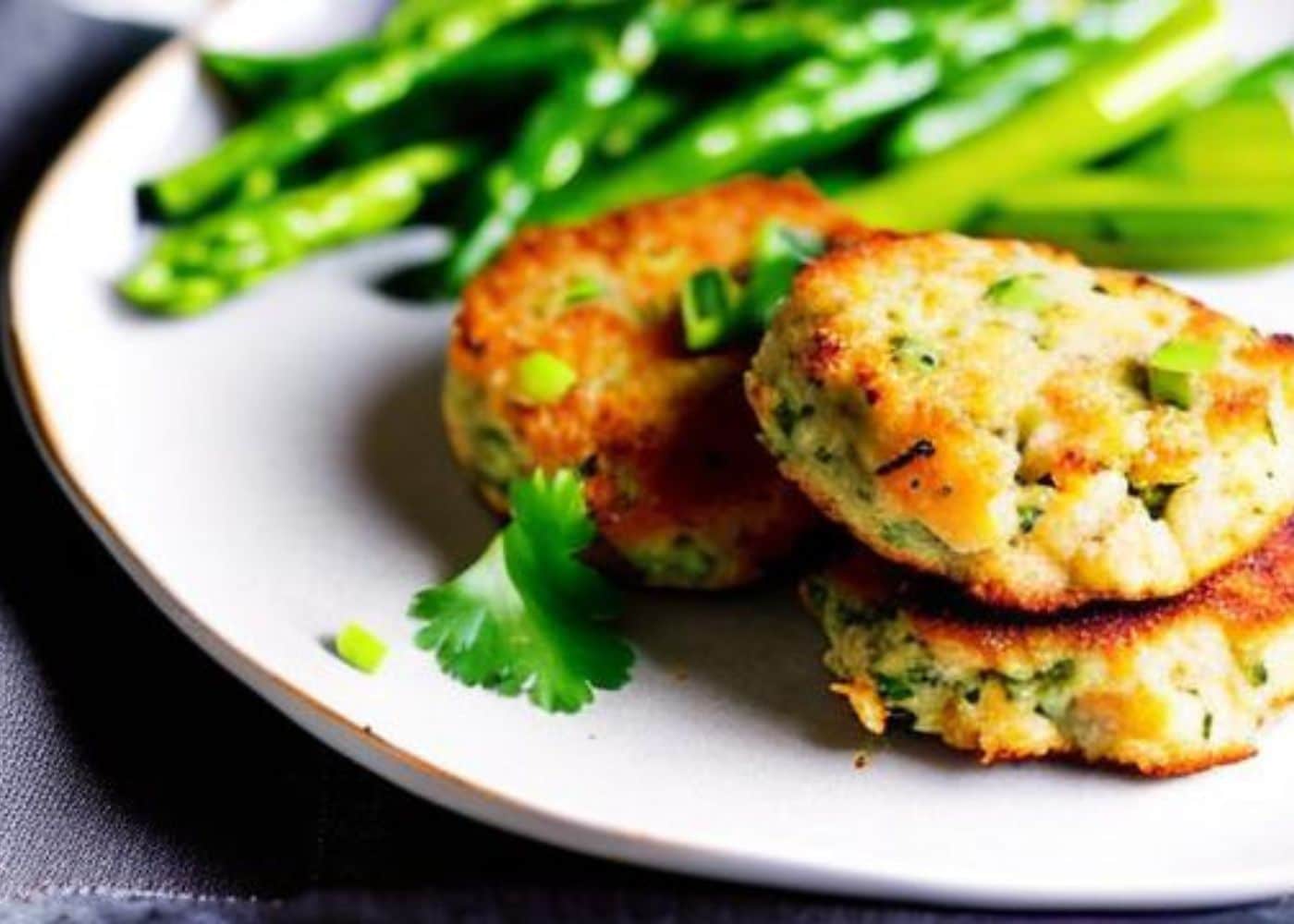
BLW Salmon Cakes
Ingredients
- 1 lb fresh salmon skin removed and diced
- 1/2 cup whole wheat breadcrumbs
- 1/4 cup onion finely chopped
- 1/4 cup celery finely chopped
- 1/4 cup red bell pepper finely chopped
- 1 large egg beaten
- 1 tbsp Dijon mustard (12+ months)
- 1 tbsp fresh lemon juice
- 1 tbsp fresh parsley chopped
- Herbs and pepper to taste
- 2 tbsp extra virgin olive oil
Instructions
- Preheat your oven to 375°F (190°C)
- Combine the diced salmon, breadcrumbs, onion, celery, red bell pepper, egg, Dijon mustard, lemon juice, parsley, herbs, and pepper in a large bowl.
- Mix the ingredients until they are evenly combined.
- Using your hands, form the mixture into small patties about 2-3 inches in diameter.
- Heat the olive oil in a large skillet over medium-high heat.
- Add the salmon cakes to the skillet and cook for 2-3 minutes on each side or until lightly browned.
- Transfer the salmon cakes to the oven and bake for 10-12 minutes or until they are fully cooked and crispy.
- Let the salmon cakes cool for a few minutes before serving to your baby.
Notes
- Make sure to remove any bones from the salmon before dicing it.
- If you want to make the salmon cakes ahead of time, you can refrigerate the uncooked patties for up to 24 hours before cooking them.
- You can also freeze the cooked salmon cakes for up to 3 months. Bake them in the oven at 375°F (190°C) for 10-15 minutes to reheat.
Combining salmon with vegetables and spices makes for a flavorful and nutritious meal.
These salmon cakes are also easy to make and can be customized using different herbs or adding additional ingredients such as grated carrots or zucchini.
Baked Salmon and Sweet Potato Fingers
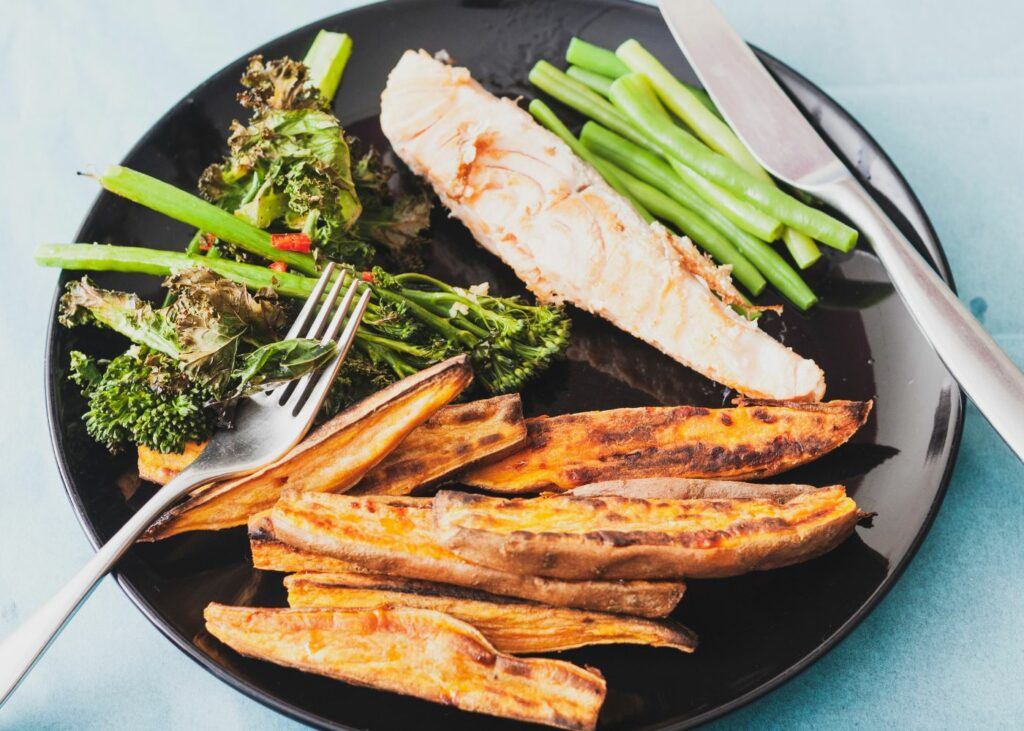
Ingredients:
- 1 lb boneless salmon fillet, skin removed and cut into finger-sized pieces
- One large sweet potato, peeled and cut into wedges
- 1 tbsp of extra virgin olive oil
- 1 tsp paprika
- 1/2 tsp garlic powder
- Herbs and pepper to taste
Steps:
- Preheat your oven to 400°F (200°C).
- Mix the olive oil, paprika, garlic powder, herbs, and pepper in a bowl.
- Add the sweet potato fingers to the bowl and toss until they are evenly coated with the spice mixture.
- Place the sweet potato fingers on one side of the prepared baking sheet and bake for 15-20 minutes or until tender and slightly browned.
- While the sweet potato fingers are baking, arrange the salmon fingers on the other side of the baking sheet.
- Brush the salmon fingers with the remaining spice mixture and bake for 10-12 minutes or until the salmon is fully cooked and flakes easily with a fork.
This recipe is a great way to introduce your baby to salmon and sweet potatoes, which are both nutritious and delicious.
The sweet potatoes add a natural sweetness to the dish, while the spices give it a flavorful kick.
This recipe is also easy to customize by adjusting the amount of spice or adding additional ingredients such as herbs or lemon juice.
You can also cook salmon and sweet potatoes in an air-fryer.
Salmon Rice balls

Ingredients:
- 1 lb fresh salmon, skin removed and finely diced
- 2 cups cooked brown rice
- 1/4 cup finely chopped scallions
- 1 tbsp fresh lemon juice
- One large egg, beaten
- 1/4 cup whole wheat breadcrumbs
- 1 tbsp extra virgin olive oil
Steps:
- Combine the diced salmon, cooked brown rice, scallions, lemon juice, and beaten egg in a large bowl. Mix all the ingredients.
- Using your hands (we love getting dirty!), form the mixture into small balls, about 3 inches in diameter.
- Place the breadcrumbs on a plate and roll each salmon rice ball in the breadcrumbs until they are fully coated.
- Heat the olive oil in a large skillet over medium-high heat.
- Add the salmon rice balls to the skillet and cook on each side for 3 minutes until lightly browned and crispy.
These salmon rice balls are a fun and easy way to introduce your baby to salmon and brown rice.
Brown rice is an excellent source of fiber and nutrients, and combining it with salmon creates a nutritious and filling meal.
This recipe is also easy to make and can be customized by adding different herbs or spices to the mixture, don’t be afraid of being creative!
Best Foods to Combine Salmon With
| Food | Reason |
|---|---|
| Sweet potatoes | Sweet potatoes are a good source of fiber and vitamins and can provide a contrasting texture and flavor to the salmon. |
| Carrots | Carrots are rich in vitamin A and can help enhance the immune system. They can also provide a naturally sweet flavor to the dish. |
| Peas | Peas are a good source of protein and fiber and can help balance out the flavor of the salmon. |
| Broccoli | Quinoa is a complete protein and can provide a balanced meal with salmon. It is also a good source of fiber and essential nutrients. |
| Brown rice | Brown rice is a good source of complex carbohydrates and can provide a nutritious base for the salmon. It can also help fill your baby up and keep them satisfied. |
| Quinoa | Pineapple contains bromelain, an enzyme that can help aid digestion and improve nutrient absorption. It can also add a tangy flavor to the dish. |
| Mango | Mango is rich in vitamin C and can help enhance the immune system. It can also provide a naturally sweet and tropical flavor to the dish. |
| Pineapple | Brown rice is a good source of complex carbohydrates and can provide a nutritious base for salmon. It can also help fill your baby up and keep them satisfied. |
| Dill | Dill is a flavorful herb that pairs well with salmon and can help enhance its natural flavor. It can also add a refreshing and herbaceous note to the dish. |
| Lemon | Lemon juice or zest can help enhance the flavor of the salmon and add a bright and acidic note to the dish. It can also provide a natural source of vitamin C. |
Baby Led Weaning Salmon FAQ
What’s the cooking time and temperature for salmon?
- Cook salmon until it is fully cooked through and flaky.
- The FDA recommends cooking fish to an internal temperature of 145°F (63°C).
Is salmon a choking hazard?
While salmon is not typically considered a choking hazard for babies, bones in freshly cooked salmon can pose a choking risk if not removed.
To reduce this risk, it’s important to carefully inspect the cooked salmon for any bones and remove them before serving it to your baby.
Is salmon a common allergen?
Yes, salmon is a typical food allergen and can cause an allergic reaction in some babies. To avoid potential risks, it’s important to wait up to 3 days before introducing any new food.
How do you remove the tiny bones from salmon fillets?
- Use a pair of tweezers or needle-nose pliers to remove any small bones from the salmon.
- Run your fingers along the flesh of the salmon to feel for any bones that may have been missed.
Conclusion
In conclusion, introducing salmon into your baby’s diet can be an exciting and nutritious first food option, packed with essential nutrients for growing babies.
As one of the top allergens, it’s essential to be cautious when offering salmon and watch for any signs of an allergic reaction. Do not be scared to introduce it early; it is recommended.
When prepared correctly, salmon can be a great choice for babies, as it’s an excellent source of protein, omega-3 fatty acids, and other essential nutrients for brain and cognitive development.
Happy feeding!
We’re Maria and Alberto, a married couple and educators who are nutrition enthusiasts. Even before we had kids, we were already crazy about nutrition.
We’d read scientific articles, watch videos from nutritionists, and spend hours listening to nutrition podcasts.
Today, we continue doing this, but in a different way, as we’ve learned to sift through the noise and trends. Nutrition, like any other field of knowledge, the more you read and learn, the more you develop a comprehensive understanding of reality, and that’s what has happened to us.
Before having our first child, we focused on learning everything we could about child nutrition, using the same techniques we had already employed, backed by our extensive knowledge in nutrition.
Our mission is to help other parents with their children’s nutrition, to help them become the best versions of themselves.
If we are what we eat and drink, which is absolutely true, let’s do it right!


